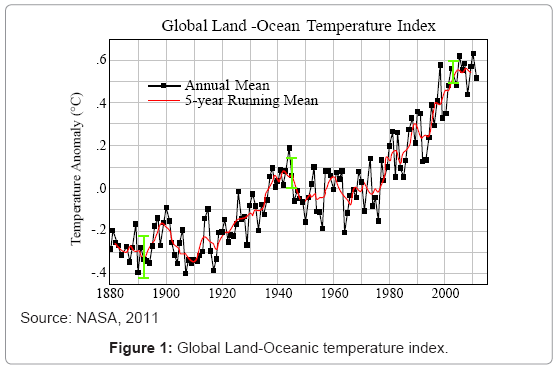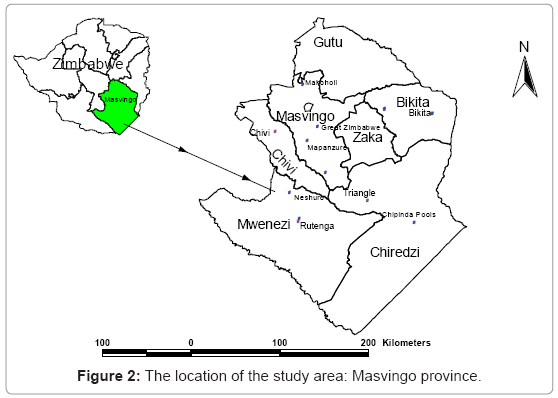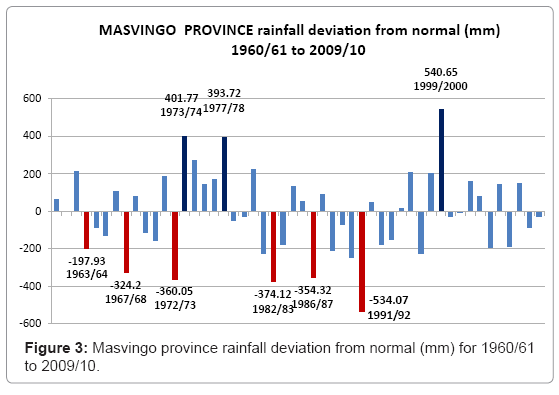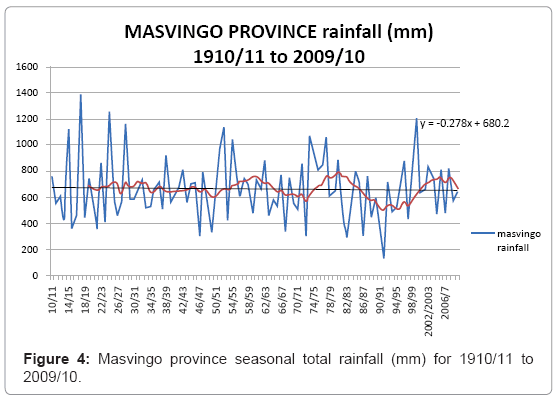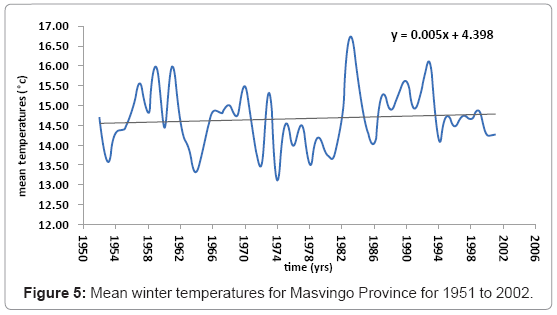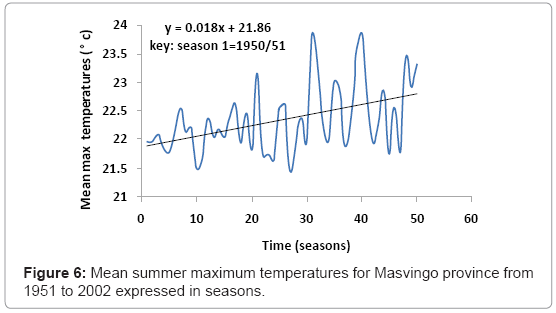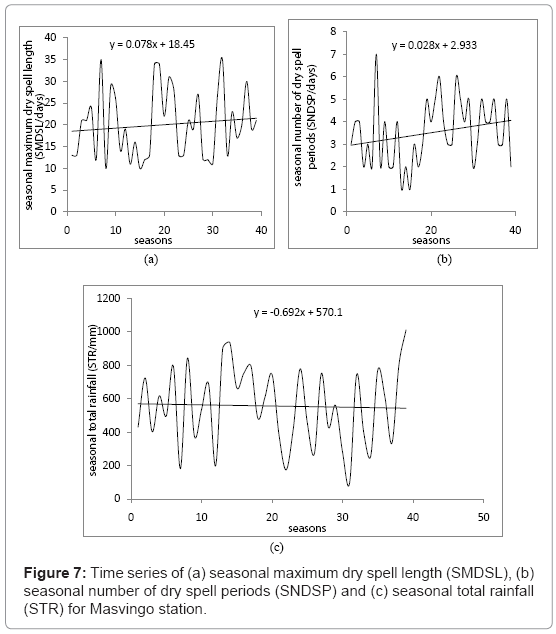Climate Change Scenarios, Perceptions and Crop Production: A Case Study of Semi-Arid Masvingo Province in Zimbabwe
Received: 29-Aug-2012 / Accepted Date: 30-Oct-2012 / Published Date: 02-Nov-2012 DOI: 10.4172/2157-7617.1000124
Abstract
The paper analyses the impacts of climate change and crop production in the communal farms of Masvingo Province in Zimbabwe. The paper shows current climate change scenarios for Masvingo, analyses the relationship between climate change scenarios crop production and then prescribe adaptive measures to climate change. Historical monthly climate data from Zimbabwe Meteorological Services Department and crop yield data from the Ministry of Agriculture and Rural Development were used. A questionnaire survey was also conducted to gather farmers perceptions on climate change in addition two focus group discussions were held with selected farmers in the province. The results showed evidence of climate change through analysis of climate data, crop yields and farmers perceptions. Evidence was manifested through the increasing frequency of droughts, dry spells and the shifts of the rainfall season. It was the concluded that climate change occurring in Masvingo has resulted in significant decline in crop production. The people’s perceptions shows that the crop growing seasons are becoming shorter, temperatures are rising, rainfall amounts are declining and mid season droughts are also occurring more frequently. The lessons learnt mean that people are aware of climate change and its impacts on crop production but lack the means to adapt to these changes.
Keywords: Climate change; Crop production; Drought; Dry spells; Perceptions; Adaptation; Masvingo province
8763Introduction
Climate change in Zimbabwe is predicted to make the country drier and have higher temperatures [1]. This will have serious consequences on food production despite technological advances in plant breeding, fertilizers and irrigation systems. It is the poor and vulnerable who will be the most susceptible to changes in climate [2-4]. This is especially true for those communities who live in the dry lands of Africa and who rely largely or totally on rain fed agriculture for their livelihoods (Dimes et al., 2010).
Assessments of the impacts of climate change on crop production have been done to perfection in the developed countries, but less is known regarding the impacts in developing countries like Zimbabwe (Smith and Tirpak, 1989). The few studies on environmental change and crop production done in Zimbabwe concentrate mainly on predicting future climatic scenarios for the country and the suitability of these future climates to grow maize which is the staple crop. An example is the UN Framework Convention on Climate Change (1998), which in a study concluded that maize production in Zimbabwe at all sites show a considerable amount of variation under climate change conditions. Maize planted late will not give good yields, thus making maize production a less viable activity under climate change conditions yet it is a staple crop in Zimbabwe.
Almost none of the studies have looked at other food crops like small grains. There is therefore a need for more studies that show relationships between environmental change especially climate change and crop production over time to determine if there is a significant relationship between the two. Only when these relationships are ascertained can mitigation options then the crafted. A farmer who is observant to change in conditions of the climate can take steps to strategise ways to cope, improve crop production and can be sustainable in operations [5,6].
A Farmer’s understanding of climate change and variability is an important component in spearheading adaptation options [7,8]. Environmental change related to climate change shows altered the rainfall patterns, amplified drought cycles, increased the frequency of severe weather conditions and increased agricultural pests and diseases [1,7,9,10]. More importantly climate change has resulted in declining crop production not only in Zimbabwe but in the whole of the Southern African Development community (SADC), [8,11,12]. Smallholder farmers have become vulnerable to climate change [13]. Cotton production in Zimbabwe has been on the decline mainly due to climate change and variability. Maize production and other small grains like sorghum have also been on the decline [1,12-14]. Climate change has therefore affected staple crops, subsistence production and livestock production in general [15].
Climate variability and climate change have been apparent with high ambient temperatures recorded with an increase of global temperatures by 0.5°C attributed to global warming caused by greenhouse gases. Erratic patterns of rainfall with high frequencies and severities in floods and droughts have also been experienced since 1980 [16]. Figure 1 shows the global mean land-ocean temperature index from 1880 to 2010, with the base period 1951-1980. The black line is the annual mean and the red line is the five-year running mean. The green bars show uncertainty estimates. Figure 1 clearly shows the global warning is occurring and climate change is a reality [16,17].
Climate change in Zimbabwe also show a trend similar the global trend shown on Figure 1, daytime temperatures over Zimbabwe have risen by up to 0.8°C from 1933 to 1993, which translates to a 0.l°C rise per decade (Zimbabwe Meteorological Services Department, 1996). Precipitation has declined by up to 10% on average over the period 1900 to 1993, which is about 1% per decade. It can also be concluded that warming has been greatest over urban settlements, where both night- time and day time temperatures show an increase, consistent with the heat island effect. On a national average, minimum ambient temperatures show a cooling trend, whereas maximum temperature shows a warming trend. It is difficult at this stage to attribute the observed climatic trends to any single factor [9]. This is so because all the changes occurring in climate do not as yet show significance after statistical analysis [18]. Russell [11] revealed that six warmest years on record for Zimbabwe have occurred since 1987 and that the increased frequency of droughts since 1990 (90/91, 91/92, 92/93, 93/94, 94/95, 97/98, 01/01/02, 02/03, 04/05, 06/07) is causing massive drop in crop yields in the country’s agricultural sector.
For any adaptation and mitigation options to the impacts of climate change and variability to succeed, there is a need to access the perception of the communities [19]. Understanding the perceptions of a society must be the first step towards solving the problem because it gives an insight into the level societal understanding of the problem and also encourages the society to participate in coming up with what they think are solutions to their problems. Intervention crafted after considering people’s perceptions are most likely to succeed because they have public support, unlike situations where a few technocrats design solutions for people’s problems without their participation.
Perception is an impression, attitude or understanding based on what is observed or thought. Perception is a requisite property of animate action by a person or community. Without perception action would be unguided, and without action perception would serve no purpose [20]. Perceptions of communities on climate change are important because they can be used to produce effective participatory methodology for climate change adaptation and capacity building. Communities are not homogeneous; each has got its own unique set of problems, beliefs and perceptions, so any community level interception meant solving problems should be community specific [21,22].
Another important issue related to adaptation in agriculture pointed out by Bryant et al. [23] is how perceptions of climate change are translated into agricultural decisions. If farmers learn gradually about the change in climate, they will also learn gradually about the best techniques and adaptation options available. Farmers learn about the best adaptation options in three ways; learning by doing, learning by copying, and learning from instruction [24]. There is recognition that farmers’ responses vary when faced with the same stimuli. Such varied responses, even within the same geographic area, are partly related to the variety of agricultural systems involved and the different market systems in which farmers operate [2,3,23]. Gbetibouo [25] argues that farmers with access to extension services are likely to perceive changes in the climate because extension services provide information about climate and weather. Consequently, awareness and perceptions of a problem shapes action or inaction on the problem of climate change [26].
Failure to take community perceptions, values and views into consideration when taking decisions on climate change and mitigating management will inevitably prove problematic, for several reasons. At a local level, climate policies will require a degree of ‘buy-in’ or acceptance from those who will be affected by them if they are to be successfully implemented. Second, where public policy and citizen frames of reference differ for example regarding the balance between long-term and short-term considerations, the practice of climate risk communication becomes much more difficult. Finally, policy implementation may be misunderstood, neglected or even opposed by the electorate solely because they believe that the policy does not reflect their perceptions [27-29].
Study area
Figure 2 shows the location of the study area. Masvingo province is divided into seven districts which are; Gutu, Masvingo, Bikita, Zaka, Chivi, Mwenezi and Chiredzi. Masvingo province occupies the drier semi-arid lowveld area in the south-eastern parts of Zimbabwe. The Province is located in agro-ecological regions 3, 4 and 5 classified according to annual rainfall totals [30]. Farming activities in this region vary from crop farming to animal husbandry. With the current rainfall trends and temperatures experienced the classification is certainly distorted and farmers need to adopt certain coping strategies in terms of the type of crops they grow or shift from crop farming to animal husbandry [1].
Masvingo borders Mozambique on its eastern borders, South Africa to the southern boundary, and Matabeleland South province to the south-west, Midlands’s province to the north-west and Manicaland to the north east. The province has an area of 56,566 km2 and a population of approximately 1.3 million in 2002, (CSO, 2002). The province is largely populated by members of the Karanga tribe, who are the most populous tribe in Zimbabwe, and are a sub-group of the Shona speaking tribes that also include the Zezuru, Manyika and Ndau.
The Save, Runde, Mwenezi, Mutirikwi and Limpopo river systems dominate the drainage system in the province. Kopjes, hills and mountain ranges dot the countryside. Miombo woodlands dominate the wetter northern parts of the province while Mopani trees, which are drought tolerant, are found throughout the province.
Problem statement
Climate change occurring in Zimbabwe and in Masvingo province in particular is having a negative impact on small holder Farmers livelihood because it reduces their food security and potential income. For farmers in Masvingo province to be able to appropriately adopt to the negative impacts of climate change, first the following must be achieved: climate change scenarios for Masvingo province must first be known and understood, the relationships between crop production and changing climate must be determined in Masvingo and the community’s perceptions on climate change must also be known and understood.
Currently little or nothing is known on the above and this research aims at filling this knowledge void that will be invaluable in the formulation of policies and the implementation of mitigation and adaptation options on the climate change issue in the province.
Objectives and theoretical foundations
The objectives of this study are:
1. To determine the climatic change scenarios for Masvingo province.
2. To determine changes in crop production output under changing climatic conditions in Masvingo province.
3. To determine farmers perceptions on climate change and how it is affecting crop production in the Province.
4. Suggest possible adaptation techniques for the farmers in the province.
This research was built upon the work done by Smit et al. [31], Kolstad et al. [32], Bryant et al. [23], Belliveau et al. [33], Maddison [24], Gbetibouo [25] and hypothesises that communal farmers in Masvingo province perceive climate change to be occurring and having a negative impact on crop.
This paper attempts to answer the following questions in particular:
1. Is there a significant relationship between agricultural output and climate change in Masvingo Province?
2. Do farmers perceive climate change to have occurred already and if so have they begun to adapt?
3. What do the farmers perceive to be the signs of climate change?
4. What are the climatic scenarios for Masvingo province?
5. What are the possible adaptation techniques for the farmers?
Research Materials and Methods
The materials used in the study included the following:
1. Monthly climatic data for Masvingo province weather stations run by the Zimbabwe Meteorological Services Department (ZMSD). Monthly rainfall and temperature data used was obtained from five weather stations which are Masvingo Airport, Zaka, Buffalo Range, Chisumbanje and Makoholi stations.
2. Crop yield data for areas in Masvingo province obtained from Agricultural Research Extension (AREX). AREX is a department within the Ministry of Agriculture.
3. The study also made use of questionnaires, focus group discussion and interviews with key informants.
The study made use of the materials available in the following ways:
1. The rainfall and temperature data were used to determine climatic variability, dry spells and climatic scenarios for Masvingo province and these would be correlated to crop yield data.
2. Records for crop yields obtained from AREX were for seasons 1995/96 to 2002/03. Records that cover three districts Chibi, Chiredzi and Bikita were used because they had data which was available and also reliable. The base year 1995 was used because prior to this year the methods used in the collection of harvest data were also not reliable unreliable.
3. A questionnaire survey was used in the study to obtain information related to Masvingo farmer’s perception on climate change. The questionnaire survey was carried out after a pilot studies were carried out in each district.
The questionnaire was administered in the month of February 2012 because this is the period when farmers crop a ripe and start having reliable estimates expected yields.
The target population was mainly the oldest people of a selected community because they were considered to be able to give a pattern of weather changes over a longer period of time which was considered a more reliable picture of changes in climate. Sometimes for comparative purposes of changes of perception with age, any person of twenty years and above in age was also considered suitable.
4. Considering the population of this most useful population( people over the age of 60) 200 people was confidently selected as the best sample size that would give the best tradeoff between cost (time taken) and representativeness of the sample. This was applicable as long as the areas selected for spatial sampling were selected at random.
5. About 53 villages were visited in the province. A base map of Masvingo province was imported into a Geographical Information Systems (GIS) and then followed by the generation of 200 random points on the base map. The coordinates of random points were then loaded into a hand held Global Positioning Systems (GPS) which was then used to navigate to the selected areas.
6. A set of questions were also prepared that probed farmers on the environmental changes and crop productivity and these were used in focus group discussions. These were held at two places which are Chief Nemamwa’s homestead and Matibi 2 Area close to Gonarezhou National Park.
7. Key respondents at key institutions with specialised knowledge on climate change were selected and targeted for interviews. The interviews were carried out the same period with the questionnaire survey. The interviewees were researchers at Makoholi Research Station in Zimuto, three AREX extension workers in Chibi and Triangle Sugar Estates in Chiredzi. In general information solicited from these interviews was on climate scenarios, crop production and farmers’ perceptions.
8. The questionnaire was coded and the data was entered and analyzed using Statistical Package for Social Scientist (SPSS) package [34]. Climatic data was plotted into time series graphs with trend lines. Trend lines gave gradient information on whether the pattern was increasing or decreasing with time. The data spanned from 1951 2002. Graphs plotted were for mean winter temperatures and mean maximum summer temperature trends.
Results
Climate scenarios for masvingo
The rainfall patterns in Masvingo province show extreme variations in terms of seasonal total rainfall. Years of notable rainfall above normal include 1973 to 1978 and also from 1996 to 2000. The frequency of years below normal were more than years above normal, with extreme below normal rainfall events recorded in 1963/64, 1967/68, 1972/73, 1982/83, 1986/87 and 1991/92 which point to severe drought periods in the province. Figure 3 summarises the extreme rainfall events in Masvingo province.
Figure 4 summarises the seasonal total rainfall for Masvingo Province from 1910 to 2007. It can be realised that there is an increase in variability of seasonal total rainfall from 1950 to 2007. The trend line is indicating a slight decrease in the total rainfall over the years as given by the negative gradient in the linear equation.
While the rainfall trend shows a decrease with time, temperature trends are indicating an increase as shown by Figures 5 and 6. Figure 5 shows rising winter temperatures for Masvingo province. Winters (May to July period) are apparently becoming warmer starting from 1950 to 2002. The variations of winter temperatures are between 13 and 17°C.
Figure 6 is indicating an increase in summer temperatures as given by the trend line equation. The variations of maximum temperatures are slight i.e. between 22 and 24°C.
Trends in frequency and severity of dryspells for Masvingo station
Dryspell analysis for Masvingo province stations was done in terms of seasonal maximum dry spell length (SMDSL) and seasonal number of dry spells periods (SNDSP) using time series plots. In addition there is an overview of seasonal total rainfall for the station for the period 1962 to 2000. All the stations show a similar trend and as an illustration Masvingo station data is shown on Figure 7.
Figures 7a and 7b show increases in the dryspell length and in the number of dryspell periods. Dryspell events are in line with huge variations of seasonal total rainfall resulting in dryspell events. The seasonal total rainfall also shows a decreasing trend with time.
Crop production in masvingo province
Crop production for the province is given by variations of crop yields for maize and small grains with seasonal total rainfall. Data for yield analysis was selected for three districts in Masvingo province which are Chiredzi, Chivi and Bikita. Figures in this section show variation of yields with seasonal total rainfall for the corresponding seasons. Seasons span from 1995/1996 to 2002/2003 period. The tables indicate level of sensitivity of the rainfed crops to incident rainfall variability assuming agronomic practices remain constant.
Crop production in bikita district
Table 1 illustrates variation of small grains which are sorghum, rapoko and millet with rainfall received. For sorghum, maximum yield is realized in those seasons where there is less rainfall. Only season 1996/1997 shows a yield trend that is consistent with rainfall. For rapoko, the yields are generally directly related to the rainfall trends. Millet yields are very high in season 2001/2002, but have not been significant in the other seasons. Rainfall varied from 500 mm to 1400 mm for the district over the period.
| Season | Rainfall (mm) | Sorghum (tonnes) | Rapoko (tonnes) | Millet(tonnes) |
| 1996/1997 | 729.4 | 1836 | 2604 | 731 |
| 1997/1998 | 389.6 | 1025 | 1033 | 102 |
| 1998/1999 | 817.1 | 1904 | 2589 | 698 |
| 1999/2000 | 1134.8 | 879 | 1190 | 640 |
| 2000/2001 | 675.5 | 1218 | 3442 | 1030 |
| 2001/2002 | 712.2 | 475 | 335 | 1743 |
| 2002/2003 | 929.3 | 518 | 1340 | 179 |
| 2003/2004 | 949.6 | 1456 | 1583 | 384 |
| 2004/2005 | 515.3 | 926 | 795 | 307 |
| 2005/2006 | 965.8 | 2250 | 4694 | 907 |
| 2006/2007 | 466.6 | 1403 | 3058 | 746 |
| 2007/2008 | 847.9 | 2186 | 3108 | 184 |
| 2008/2009 | 964.8 | 3674 | 7937 | 2172 |
| 2009/2010 | 709.5 | 842 | 1403 | 360 |
Table 1: Variation of seasonal rainfall and small grains yield for Bikita district.
Crop production for chivi district
Tables 2 and 3 summarize variation of yields with rainfall. Table 2 shows variations of maize and rainfall for Chivi district. For all the seven seasons the rainfall trend is consistent with the yield trend with highs for rainfall resulting in highs for yield the same with lows.
| Season | Rainfall (mm) | Maize (tonnes) |
| 1996/1997 | 729.4 | 3009 |
| 1997/1998 | 389.6 | 3458 |
| 1998/1999 | 817.1 | 15807 |
| 1999/2000 | 1134.8 | 28569 |
| 2000/2001 | 675.5 | 891 |
| 2001/2002 | 712.2 | 37032 |
| 2002/2003 | 929.3 | 11047 |
| 2003/2004 | 949.6 | 12754 |
| 2004/2005 | 515.3 | 22841 |
| 2005/2006 | 965.8 | 676 |
| 2006/2007 | 466.6 | 4953 |
Table 2: Variation of seasonal rainfall and maize yield for Chivi district.
| Season | Rainfall (mm) | Sorghum (tonnes) | Pearl millet(tonnes) | Finger millet (tonnes) |
| 1996/1997 | 729.4 | 3132 | 2270 | 760 |
| 1997/1998 | 389.6 | 5120 | 210 | 390 |
| 1998/1999 | 817.1 | 2333 | 1373 | 1085 |
| 1999/2000 | 1134.8 | 6828 | 2430 | 1458 |
| 2000/2001 | 675.5 | 1878 | 82 | 627 |
| 2001/2002 | 712.2 | 15900 | 719 | 2629 |
| 2002/2003 | 929.3 | 13574 | 1200 | 1200 |
| 2003/2004 | 949.6 | 2506 | 910 | 627 |
| 2004/2005 | 515.3 | 15894 | 1968 | 2056 |
| 2005/2006 | 965.8 | 1646 | 299 | 253 |
| 2006/2007 | 466.6 | 3582 | 328 | 493 |
Table 3: Variation of seasonal rainfall and small grains yield for Chivi district.
Table 3 illustrates variation of small grain crops (sorghum, peal millet and finger millet) with rainfall patterns. For sorghum, maximum yield is in season 2002/2003 which corresponds to the maximum of total rainfall. Finger millet attained its maximum yield in season 2001/2002 which corresponded to maximum total seasonal rainfall. Generally the crop yields are consistent with rainfall. Peal millet has a maximum yield in season 1999/2000 and the crop yields are generally in line with rainfall patterns i.e. highs for rainfalls have highs for yields the same for lows.
Community perception on climate change
This section deals with farmer’s percerptions on climate change and environmental changes based on what they observed over the years they lived in their respective areas.
Table 4 illustrates responses from communal farmers with regards to what they observed over the time they have lived in their communities. The general responses indicate that the rainfall patterns are now erratic in Masvingo Province and no longer supported crop production and those seasons have become shorter. Farmers are also observing increasing ambient temperatures especially in summer which are responsible for high evapotranspiration rates.
| Observation | S.A % | DK % | DA % | No response % | Total % |
| Winters becoming warmer | 57.3 | 2.4 | 33.3 | 7.0 | 100% |
| Winters becoming cooler | 41 | 3.5 | 46.7 | 8.8 | 100% |
| Summers becoming cooler | 17 | 3.0 | 13.5 | 66.7 | 100% |
| Summers becoming hotter | 86 | 4.6 | 5.3 | 4.1 | 100% |
| Rainfall supporting crop production | 86.6 | 0 | 7.1 | 6.4 | 100% |
| Increase in flood incidences | 24.6 | 2.3 | 65 | 8.2 | 100% |
| Rains coming late | 73.7 | 1.2 | 9.9 | 15.2 | 100% |
| Rains ceasing early | 73.7 | 2.4 | 9.9 | 14.0 | 100% |
| Increase in pests and diseases | 73.1 | 6.5 | 9.9 | 10.5 | 100% |
| Any devegetation observed | 70.8 | 5.9 | 17 | 6.4 | 100% |
| Wood scarcity | 69 | 0 | 24.6 | 6.4 | 100% |
| Change in forest resources | 71.4 | 2.3 | 18.8 | 7.6 | 100% |
Table 4: Responses from communal farmers on their perceptions on climate patterns and environmental changes given as percentage frequencies.
Farmers’ perceptions on climatic conditions are in line with the scientific observation in terms of climate and environmental changes. About 57% of them observed that winters are becoming warmer, 86% observed hotter summers. Farmers are generally saying rainfall is not supporting crop yields, no flood incidents are notable in the province but they say rainfall seasons have become shorter. Onset of rains is delayed to mid November and cessation time ended early. About 71.4% of farmers have observed significant disappearance and damage to forests due to adverse climatic conditions.
Discussion
Climate change is a reality in Masvingo province. Masvingo’s rainfall is decreasing with time and is characterized by extreme events in form of droughts and high temperatures. This is in line with the Zimbabwe rainfall situation (ZMSD, 1996). The rainfall is not enough to support crop production and confirms that Zimbabwe especially Masvingo province will be a non-maize producing region in the future (UN, 1998).Temperatures are increasing as shown by Figures 5 and 6 and this is in line with the global warming phenomenon (NASA, 2011). The rates of evapotranspiration are very high and crops are easily moisture stressed. Forests are disappearing and there is general strain on biodiversity.
Yields for maize are very sensitive to rainfall trends. High rainfalls result in high yields and the reverse is true. Yields for small grains are less controlled by rainfall trends though. Tables 1- 3 show that small grains thrive in both wet and dry seasons [1]. However, from the four small grain crops assessed sorghum thrive very well in dry seasons and millet least in these conditions. Therefore a lot of farmers should grow small grains as opposed to maize as an adaptive measure. The yield trends are however also affected by agronomic conditions which are assumed in this case to be in place. Communal farmers many times do not have resources in form of fertilizers and machinery to boost their yield.
Perceptively farmers indicated that there are changes in the seasons with rainfalls beginning late and ceasing early and other studies by de Jonge [6] have indicated a similar trend. Farmers also observed high ambient temperatures in the province as studies have shown [5]. Generally farmers are observant of changes that have taken place in the climate and their surrounding environment. Farmer’s perceptions on climate change are important in strategizing the adaptation and mitigation changes [8]. The observations are also indicative of the farmer’s preparedness to harness new farming methods and techniques. Farmers have to react to climate change relying on the local knowledge and the scientific data from the ZMSD for appropriate adaptation.
Adaptation Techniques
There is need for communal farmers in Masvingo Province to shift from rain fed agriculture to irrigated farming. Masvingo is a province is endowed with numerous water bodies by virtue of being located in the low lying region of the country and receives water from different surrounding uplands. Investing in effective irrigation can go a long way in improving crop productivity in the province [35]. Farmers should also tap into ground water harvesting to supplement water in open bodies.
Drought resistant crops like most small grains guarantee food security and are worthwhile. In the face of increased dry spells, farmers should adopt staggered planting which reduce on risk of losing out completely in the event of protracted absence of rain during the season. Early maturing seed varieties can help as an adaptive measure in light of the shortened rain seasons.
There is need for communal farmers to seek advice from agricultural extension officers on when to plant, which seed varieties, soil nutrient analysis for better soil management and the expected climate for the season ahead of them.
Conclusion
The research revealed that most communal farmers are observant and aware of the changes taking place around them. The study revealed that respondents are acknowledging problems they are observing in climatic conditions and in changes in their surrounding environment. Most respondents on the other hand said they are experiencing very high ambient temperatures in summer over the past two decades. Generally the respondents were worried about the erratic pattern of rains and said the rainfall season had become shorter and there has been a high frequency in midseason droughts or dry spells especially in the month of January.
Dry spells of a thirty day length were reported and have been prominent in the past two decades. Masvingo province is made of three agro ecological regions which are regions 3,4 and 5 and even the known region 3 areas like Zaka, Bikita and Zimuto were crop farming is dominant had respondents confirming changes in rainfall patterns for the bad and high temperatures which are resulting in high levels of evapotranspiration depriving crops of the moisture they need for growth. Masvingo province is experiencing an increase in ambient temperatures over the years with winters also becoming warmer and summers even hotter. The province however is dominated by numerous water bodies by virtue of being located in the low veld region of the country. Farmers can harness water available and invest in irrigation projects rather than practice rainfed. However communal farmers complained that they are not given part to contribute in the decision making to air their grievances to policy makers.
References
- Makadho JM (1996) Potential Effects of Climate on Corn Production in Zimbabwe. Climate Research 6: 147-151.
- International Resources Group (2008) Impacts Of Climate Change On Rural Livelihoods In Madagascar And The Potential For Adaptation.
- Dhaka BL, Chayal K, Poonia MK (2010) Analysis of Farmers’ Perception and Adaptation Strategies to Climate Change Libyan Agriculture Research Center Journal International 1: 388-390.
- Nzeadib TC, Egbule CL, Chukwuone NA, Agu VC (2011) Climate change awareness and resilient adaptation: indigenous drivers of regional sti policy in niger delta, The first Climate Change and Development in Africa.
- Fischer G, Shah M, Tubiello FN, Van Velhuizen H (2005) Socio-Economic and Climate ChangeImpacts on Agriculture: An Integrated Assessment, 1990-2080. Phil Trans R Soc B 360: 2067-2083.
- De Jonge AE (2010) Farmers’ perception on adaptation to climate change: A case study of irrigators in the Riverland, South Australia. Master thesis Land Degradation and Development Group submitted in partial fulfillment of the degree of Master of Science in International Land and Water Management at Wageningen University, the Netherlands.
- Yanda PZ (2010) Climate Change Impacts, Vulnerability and Adaptations in Southern Afrrica. SARUA Leadership Dialogue Series 2: 11-30.
- Makungwa S (2010) Adaptation, Agriculture and Food Security. SARUA Leadership Dialogue Series 2: 68-80.
- Unganai L (1996) Historic and future climatic change in Zimbabwe Climate Research 6: 137 - 145.
- Hewitson BC (2010) Climate Change Scenario Development in Sub-Saharan Africa. SARUA Leadership Dialogue Series 2: 46-67.
- Mutekwa V (2009) Climate Change Impacts and Adaptation in the Agricultural Sector: The Case of Smallholder farmers in Zimbabwe. Journal of Sustainable Development in Africa 11: 237-256.
- Gwimbi P (2009) Cotton Farmers’ Vulnerability to Climate Change in Gokwe District (Zimbabwe): Impact and Influencing Factors. JAMBA: Journal of Disaster Risk Studies 2: 81-92.
- Jerie S, Ndabaningi T (2011) The Impact of Rainfall Variability on Rain-fed Tobacco in Manicaland Province of Zimbabwe. Journal of Sustainable Development in Africa 143.
- McCright AM (2009) The Social Bases of Climate Change Knowledge, Concern and Policy Support in the U.S. General Public. Hofstra Law Review 37: 1017-1046.
- IPCC (2007): Climate Change 2007: The Physical Science Basis. Contribution of Working Group I to the Fourth Assessment Report of the Intergovernmental Panel on Climate Change.
- Mazvimavi D (2010) Climate Change, Water Availability and Supply. SARUA Leadership Dialogue Series 2: 81-97.
- Gibson, James (2002) A Theory of Direct Visual Perception. In: Alva Noë/Evan Thompson (Eds.),Vision and Mind. Selected Readings in the Philosophy of Perception, Cambridge, MIT Press 77-89.
- Turton A (2002) The Construction of Knowledge and Implications for Climate Change Debate: A Perspective from the Developing South Centre for International political Studies, University of Pretoria.
- Sundblad E (2008) Peoples Knowledge about Climate Change: Uncertainty as a Guide to Future Commitments, University of Gothenburg, Gothenburg.
- Bryant RC, Smit B, Brklacich M, Johnston RT, Smithers J, et al. (2000) Adaptation in Canadian agriculture to climatic variability and change. Climatic Change 45: 181-201.
- Maddison D (2006) The perception of and adaptation to climate change in Africa.
- Gbetibouo G (2009) Understanding farmers' perceptions and adaptations to climate change and variability: The Case of the Limpopo Basin, South Africa. Environment and Production Technology Division, International Food Policy Research Institute.
- Speranza CI (2010) Resilient adaptation to climate change in African agriculture. Bonn: German Development Institute (DIE).
- Olmos S (2001) Vulnerability and adaptation to climate change: concepts, Issues, Assessments Methods. Climate Change Knowledge Network Foundation Paper, Oslo.
- Reidlinger D (2000) Contributions of Traditional Knowledge to Understanding Climate Change in the Canadian Arctic, Natural resources Institute, University of Manitoba, Manitoba.
- Lotz-sisitka H (2010) Knowledge Questions associated with the Public Health and Climate Change relations: Some Implications for Universities in Southern Africa. SARUA Leadership Dialogue Series 2: 101-114.
- Vincent V, Thomas RG (1960) An agricultural survey of Southern Rhodesia: Part I: agro-ecological survey. Government Printer, Salisbury.
- Smit B, McNabb D, Smithers J (1996) Agricultural adaptation to climatic variation. Climatic Change 33: 7-29.
- Kolstad C, Kelly D, Mitchell G (1999) Adjustment costs from environmental change induced by incomplete information and learning. Working Paper 10-99. Department of Economics, University of California, Santa Barbara.
- Belliveau S, Bradshaw B, Smit B, Reid S, Ramsey D, et al. (2006) Farm-level adaptation to multiple risks: Climate change and other concerns. Occasional paper No. 27. Canada: University of Guelph.
- Miller RL, Acton C, Fullerton DA (2006) Statistical Package for Social Scientists for Windows Version 15.0. SPSS Inc. USA.
Citation: Simba FM, Chikodzi D, Murwendo T (2012) Climate Change Scenarios, Perceptions and Crop Production: A Case Study of Semi-Arid Masvingo Province in Zimbabwe. J Earth Sci Climate Change 3: 124. DOI: 10.4172/2157-7617.1000124
Copyright: ©2012 Simba FM, et al. This is an open-access article distributed under the terms of the Creative Commons Attribution License, which permits unrestricted use, distribution, and reproduction in any medium, provided the original author and source are credited.
Select your language of interest to view the total content in your interested language
Share This Article
Recommended Journals
Open Access Journals
Article Tools
Article Usage
- Total views: 19666
- [From(publication date): 11-2012 - Dec 21, 2025]
- Breakdown by view type
- HTML page views: 14375
- PDF downloads: 5291

